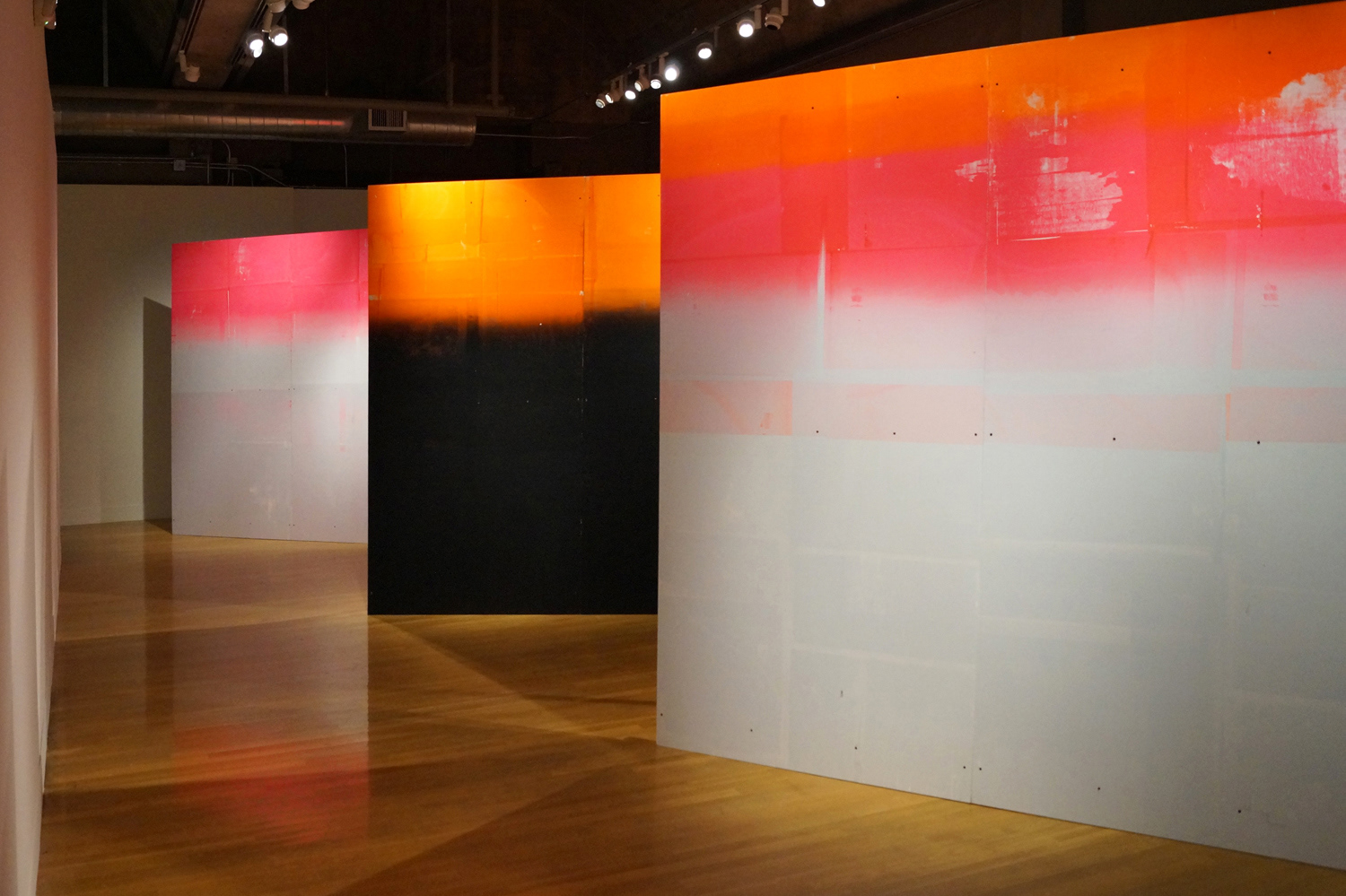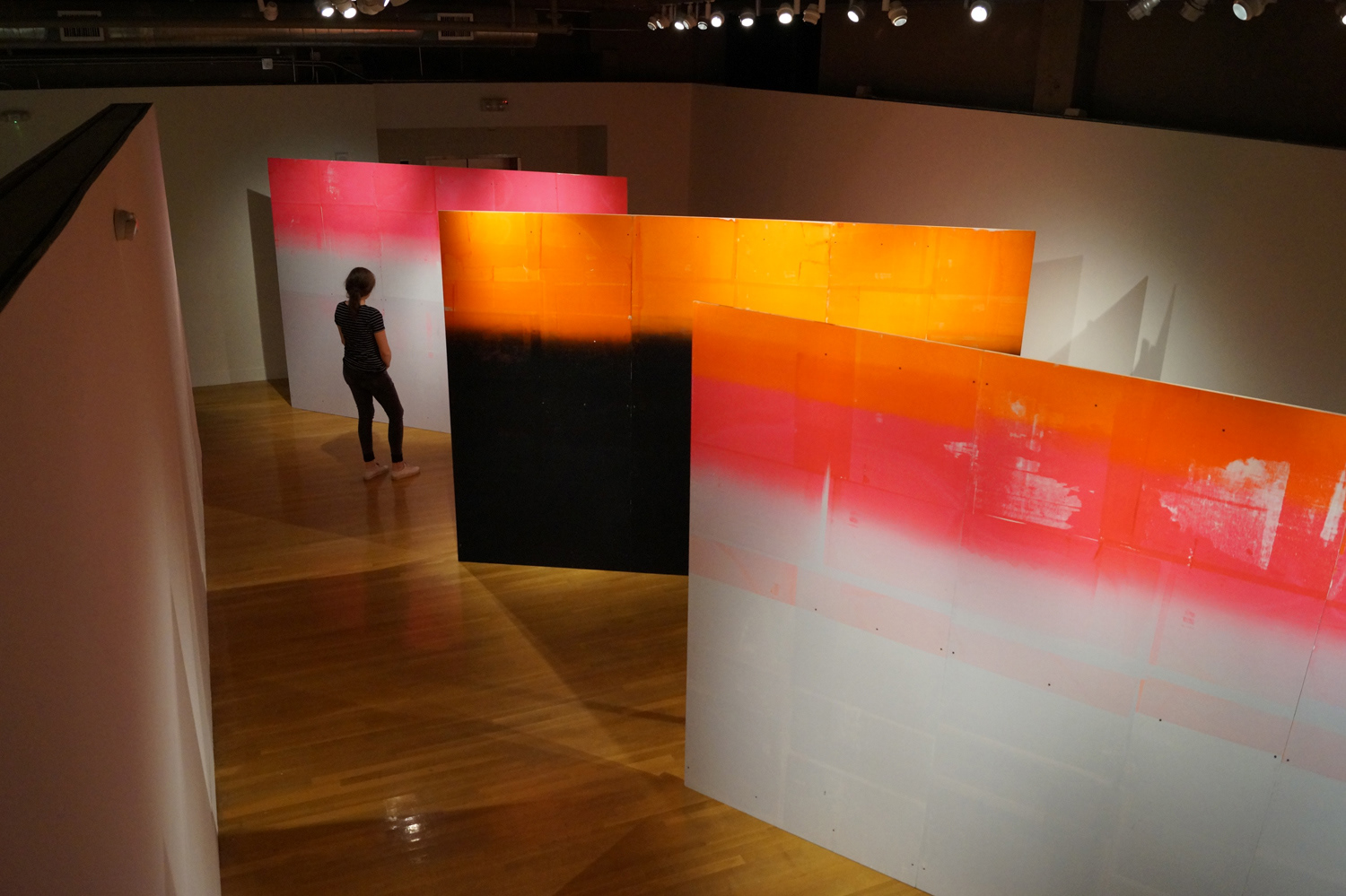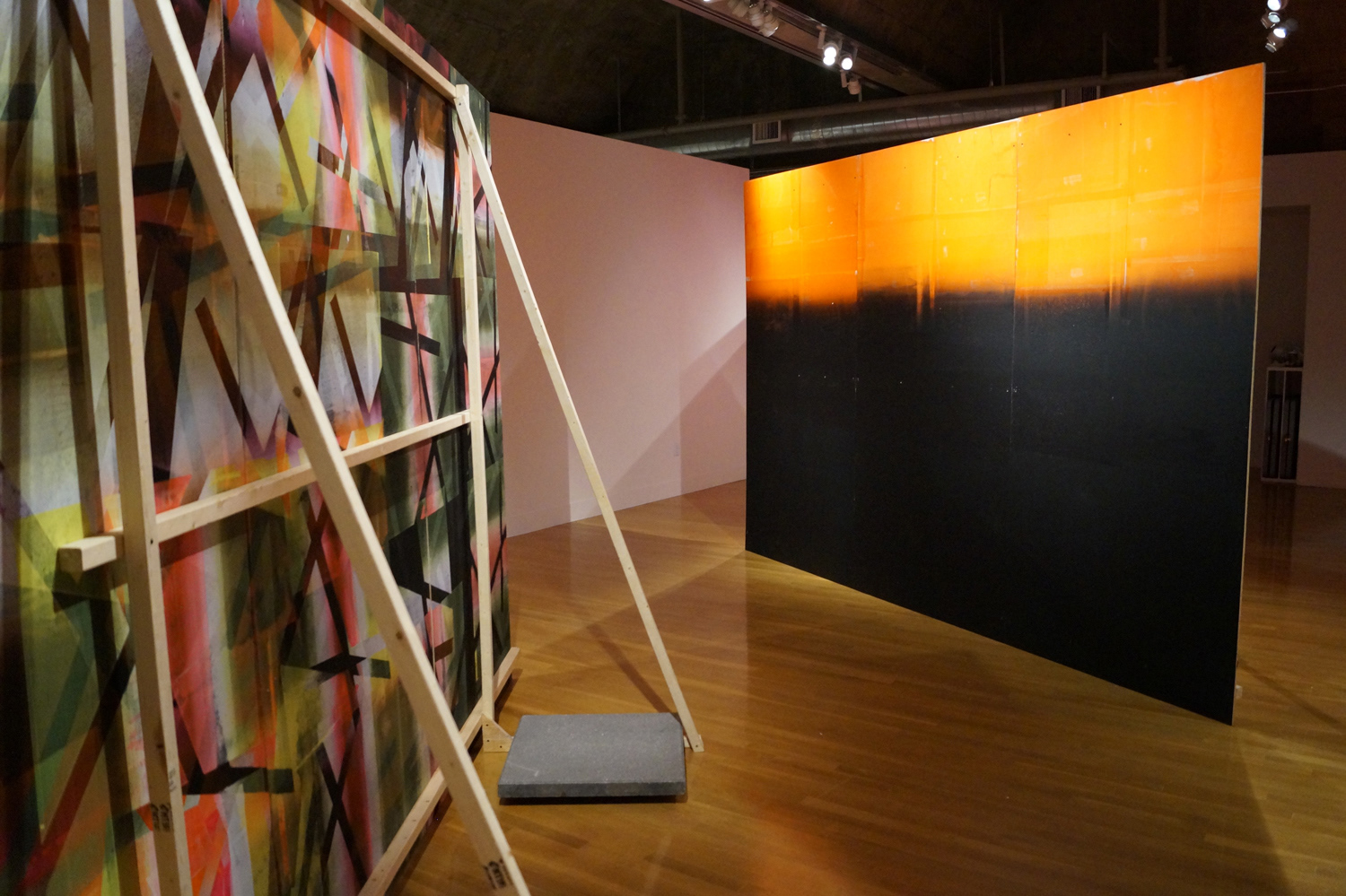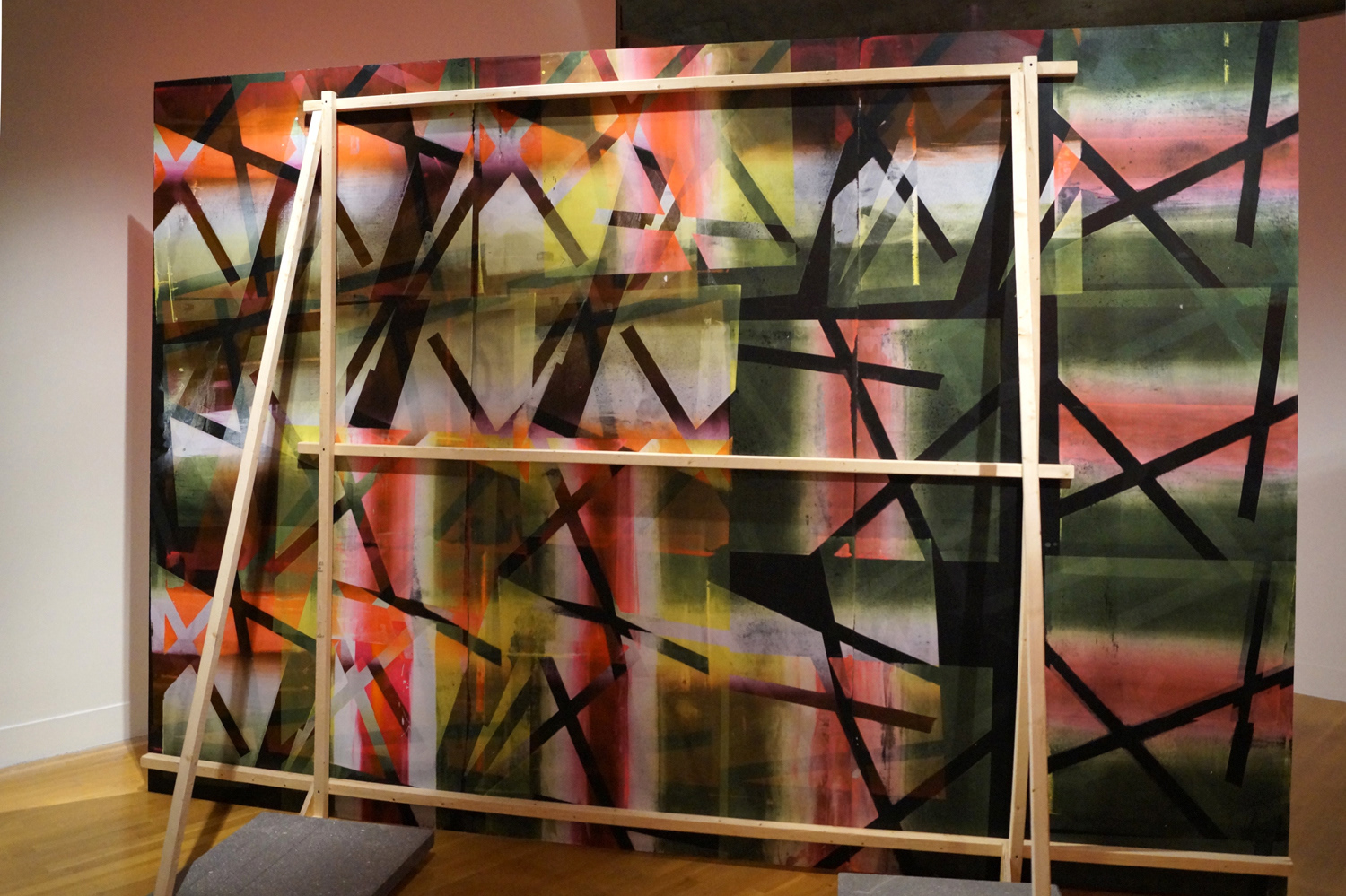
die Wand / die Mauer, 2016, Fieldwork Project Space at the Visual Art Center of University of Texas in Austin, USA

die Wand / die Mauer, 2016, Fieldwork Project Space at the Visual Art Center of University of Texas in Austin, USA

die Wand / die Mauer, 2016, Fieldwork Project Space at the Visual Art Center of University of Texas in Austin, USA

die Wand / die Mauer, 2016, Fieldwork Project Space at the Visual Art Center of University of Texas in Austin, USA
“Christian Gfeller and Anna Hellsgård: Die Wand / Die Mauer”
Fieldwork, Visual Art Center at the University of Texas at Austin, Austin, TX
19 – 28 October 2016
In “Die Wand / Die Mauer,” Christian Gfeller and Anna Hellsgård used freestanding, screen-printed billboards to slice up the Fieldwork project space inside the University of Texas at Austin Visual Arts Center. Three eight-foot-tall, twelve-foot-wide walls were arranged in parallel, cutting diagonally through the room, towering over visitors and obscuring the view of the space. The front sides were screen-printed with gradients of fluorescent pinks and oranges, fading into neutral whites and blacks, while on the backsides the artists layered stencils haphazardly using crisscrossed masking tape to produce a noisy mishmash of pattern and color.
Gfeller and Hellsgård, a Franco-Swedish duo, are the owners of Re:Surgo!, a screen-print atelier and shop in Berlin, and longtime exhibitors at the New York Art Book Fair. “Die Wand / Die Mauer” was their first large-scale, temporary installation and was executed on site over the course of two manic weeks as part of the university’s Guest Artist in Print Program.
Wand and Mauer are both German words for “wall,” but they connote very different things. The former refers to an interior building wall—the wall of a room; the latter specifies something heavier and fortified—most famously, the Berliner Mauer that divided West Berlin from East Germany. The two nouns suggest the distinctly different purposes that can be served by the same simple structure. Walls define spaces and communities; that which protects and insulates can also divide and alienate.
Gfeller and Hellsgård’s structures were built of thick plywood and propped up with simple lumber and concrete pavers. Reminiscent of makeshift fences found at urban construction sites, they might provide shelter, but like Richard Serra’s controversial 1981 public sculpture Tilted Arc, they also hindered the flow of traffic and restricted passage. Walking into the space, the viewer was confronted with behemoth structures, but as one squeezed past them, their physical authority became more dubious, the shoddiness of their materials more visible. The perfection of the white cube gallery served to emphasize the gritty imperfections of the rough wood; there was none of screen-print’s habitual slickness; the passage of a squeegee only accentuated the substrate’s flaws. Up-close viewing revealed endless accidental beauty and surprises.
In their abstraction, formalism and chromatic interest, the walls made a nod to the vacuum-sealed aesthetics of Color Field painting, but as rough-and-tumble freestanding barriers, in Texas, in the fall of 2016, they carried a wealth of other allusions. More than 25 years after the fall of the Berlin Wall, an American president is agitating for a wall to seal the U.S. border with Mexico. Gfeller and Hellsgård’s residency took place just before the election, and the subject came up regularly among the artists and their volunteer assistants. Coming from Berlin, a city ruptured by a wall, to Texas, a border state in the midst of national debate about wall-building, Gfeller and Hellsgård were drawn to the subject in all its ambiguity. In Germany too elections are looming and city streets are lined with political billboards—signage that was a further inspiration to the artists. To pedestrians, these freestanding walls with rear support anchoring them to the ground are both obstacles and advertisements. “Die Wand / Die Mauer” raised all these issues without descending into polemic.
- Jason Urban
In “Die Wand / Die Mauer,” Christian Gfeller and Anna Hellsgård used freestanding, screen-printed billboards to slice up the Fieldwork project space inside the University of Texas at Austin Visual Arts Center. Three eight-foot-tall, twelve-foot-wide walls were arranged in parallel, cutting diagonally through the room, towering over visitors and obscuring the view of the space. The front sides were screen-printed with gradients of fluorescent pinks and oranges, fading into neutral whites and blacks, while on the backsides the artists layered stencils haphazardly using crisscrossed masking tape to produce a noisy mishmash of pattern and color.
Gfeller and Hellsgård, a Franco-Swedish duo, are the owners of Re:Surgo!, a screen-print atelier and shop in Berlin, and longtime exhibitors at the New York Art Book Fair. “Die Wand / Die Mauer” was their first large-scale, temporary installation and was executed on site over the course of two manic weeks as part of the university’s Guest Artist in Print Program.
Wand and Mauer are both German words for “wall,” but they connote very different things. The former refers to an interior building wall—the wall of a room; the latter specifies something heavier and fortified—most famously, the Berliner Mauer that divided West Berlin from East Germany. The two nouns suggest the distinctly different purposes that can be served by the same simple structure. Walls define spaces and communities; that which protects and insulates can also divide and alienate.
Gfeller and Hellsgård’s structures were built of thick plywood and propped up with simple lumber and concrete pavers. Reminiscent of makeshift fences found at urban construction sites, they might provide shelter, but like Richard Serra’s controversial 1981 public sculpture Tilted Arc, they also hindered the flow of traffic and restricted passage. Walking into the space, the viewer was confronted with behemoth structures, but as one squeezed past them, their physical authority became more dubious, the shoddiness of their materials more visible. The perfection of the white cube gallery served to emphasize the gritty imperfections of the rough wood; there was none of screen-print’s habitual slickness; the passage of a squeegee only accentuated the substrate’s flaws. Up-close viewing revealed endless accidental beauty and surprises.
In their abstraction, formalism and chromatic interest, the walls made a nod to the vacuum-sealed aesthetics of Color Field painting, but as rough-and-tumble freestanding barriers, in Texas, in the fall of 2016, they carried a wealth of other allusions. More than 25 years after the fall of the Berlin Wall, an American president is agitating for a wall to seal the U.S. border with Mexico. Gfeller and Hellsgård’s residency took place just before the election, and the subject came up regularly among the artists and their volunteer assistants. Coming from Berlin, a city ruptured by a wall, to Texas, a border state in the midst of national debate about wall-building, Gfeller and Hellsgård were drawn to the subject in all its ambiguity. In Germany too elections are looming and city streets are lined with political billboards—signage that was a further inspiration to the artists. To pedestrians, these freestanding walls with rear support anchoring them to the ground are both obstacles and advertisements. “Die Wand / Die Mauer” raised all these issues without descending into polemic.
- Jason Urban